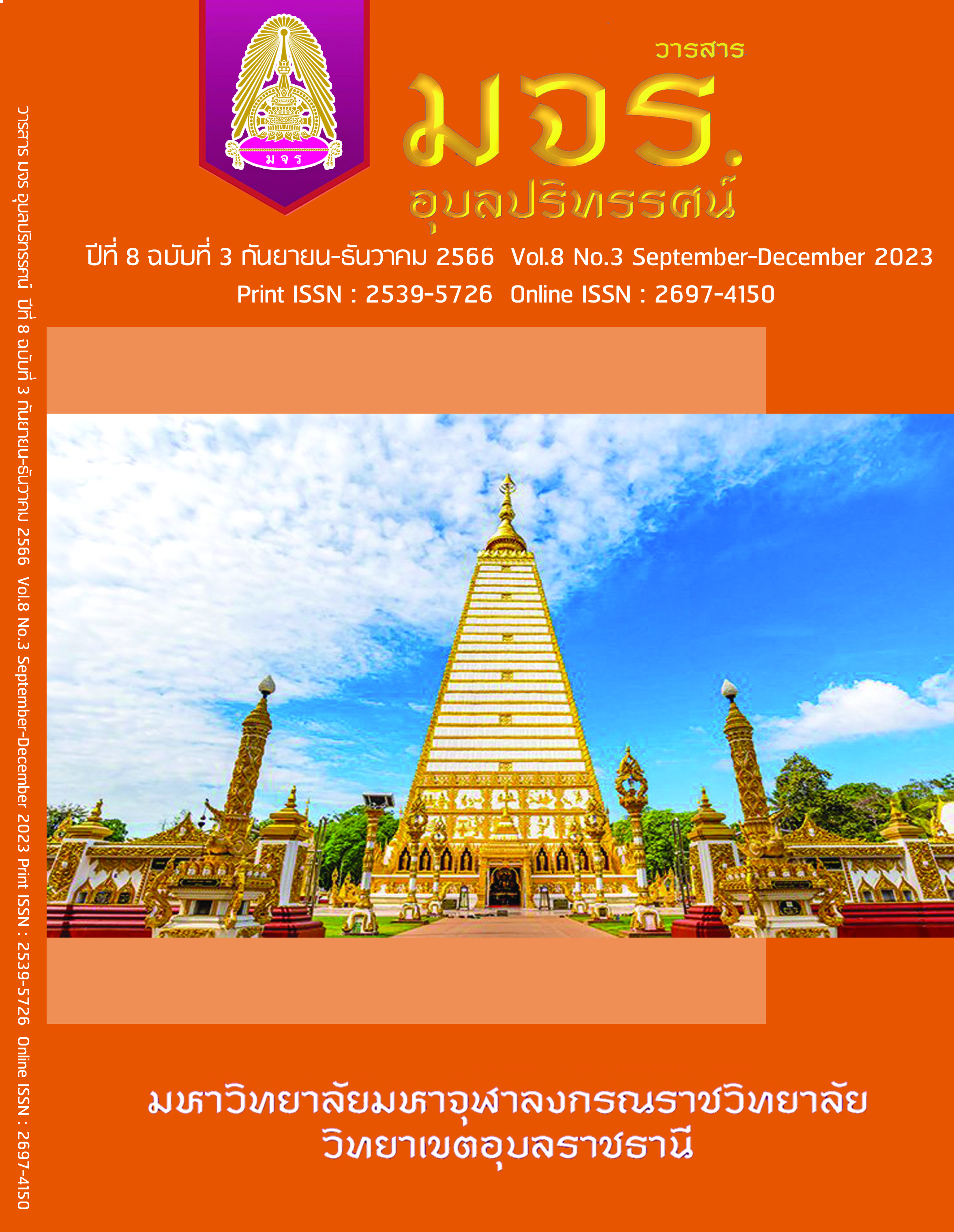The Study of Population’s Behaviors in Using and Littering Bioplastics in Bangkok
Main Article Content
Abstract
This research aims to study the perceptions influencing the behaviors in using and littering bioplastics and analyze the population's behaviors in using and littering bioplastics in Bangkok through Gibson's Field Theory. The theory, consisting of knowledge, experience, intellect, and environment, leads to suggestions on the method for consumers' behavior change and perception regarding bioplastics. It can solve the current environmental issues better. Close-ended questionnaires developed from Gibson’s Theory of Direct Perception were used as a data collection tool. Data were analyzed using inferential statistics consisting of (1) Independent T-test, (2) One-Way ANOVA, and (3) Multiple Linear Regression. To analyze the correlation of perception factors and behaviors in using and littering bioplastics of the sample population in Bangkok of 3 areas (Inner area, Central area, and Outer area) of 85 using G*Power for calculation.
The study found that the differences in sex, age and education level impact the behaviors in using and littering bioplastics, sometimes resulting in micro-plastics is statistically significant at .05. The differences in status, occupation, and members living in the same household influence the behaviors in using and littering bioplastics resulting in no micro-plastics is statistically significant at .05. The difference in income influence the behaviors in using and littering bioplastics and resulting in no micro-plastics is statistically significant at .05. Furthermore, according to Gibson's Theory of Direct Perception in intellectual effects the population's behaviors in using and littering Bioplastics in Bangkok the most.
Article Details
References
กรมควบคุมมลพิษ. สถานการณ์คุณภาพสิ่งแวดล้อมของประเทศไทย ปี 2563. [ออนไลน์]. 2564. แหล่งที่มา: https://www.pcd.go.th [26 เมษายน 2565]
จุฑากานต์ บุญมี. พลาสติกชีวภาพ (Biodegradable plastic) ทางเลือกที่เป็นมิตรกับสิ่งแวดล้อม. วารสารสิ่งแวดล้อม 16, 2 (เมษายน - มิถุนายน 2555): 15-19.
ชญานิศ ปลื้มอุดม. ความรู้ และการรับรู้เกี่ยวกับสิทธิเด็กของประชาชนในจังหวัดสมุทรปราการ. งานนิพนธ์ปริญญามหาบัณฑิต, รัฐประศาสนศาสตร์ สาขาวิชาการบริหารทั่วไป วิทยาลัยการบริหารรัฐกิจ มหาวิทยาลัยบูรพา, 2557.
ณัฐณิชา นิสัยสุข และขวัญกมล ดอนขวา. ปัจจัยที่มีผลต่อพฤติกรรมการซื้อผลิตภัณฑ์ที่เป็นมิตรกับสิ่งแวดล้อมของผู้บริโภค. วารสารชุมชนวิจัย มหาวิทยาลัยราชภัฏนครราชสีมา 9, 2 (เมษายน - ธันวาคม 2558): 57-67.
ธัญสมร คุ้มอ่า และสวรรยา ธรรมอภิพล. แรงจูงใจของผู้บริโภคเจเนอเรชั่นวายในการใช้แก้วน้ำส่วนตัว แลกส่วนลดราคาเครื่องดื่ม กรณีศึกษา คาเฟ่ อเมซอน. Journal of Management and Development Ubon Ratchathani Rajabhat University 6, 2 (กรกฎาคม - ธันวาคม 2562): 267-287.
นันทิรา วรกาญจนบุญ. การศึกษาประสิทธิภาพการกำจัดไมโครพลาสติกในน้ำเสีย. วารสารสภาการสาธารณสุขชุมชน 2, 1 (มกราคม - เมษายน 2563): 29-34.
ปารมี พัฒนดุล และวิโรจน์ เจษฎาลักษณ์. ปัจจัยที่มีผลต่อการตั้งใจซื้อผลิตภัณฑ์เพื่อสิ่งแวดล้อมของผู้บริโภค อำเภอปากเกร็ด จังหวัดนนทบุรี. Veridian E-Journal, Silpakorn University (Humanities, Social Sciences and arts) 9, 2 (พฤษภาคม–สิงหาคม 2559): 857-872.
ภุชงค์ แซ่เล้า. พลาสติก 101 : พี่ย่อยได้นะ หนูเชื่อหรอ?. [ออนไลน์]. 2562. แหล่งที่มา: https://www.greenpeace.org/thailand/story/6290/plastic-101-biodegradable/ [23 กรกฎาคม 2563]
ศุภกิจ สุทธิเรืองวงศ์ และสุจิตรา วาสนาดำรงดี. ข้อเท็จจริง “พลาสติกย่อยสลายได้ในสภาวะแวดล้อมธรรมชาติ” (Environmentally Degradable Plastics: EDP). วารสารสิ่งแวดลอม 23, 2 (เมษายน-มิถุนายน 2562): 1-8.
สถาบันพลาสติก. พัฒนาการพอลิเมอร์ชีวภาพสู่นวัตกรรมพลาสติกรักษ์โลก. วารสาร PlasticsForesight 8, 2 (กรกฎาคม - สิงหาคม 2553): 183-185.
สุกฤตา ปุณยอุปพัทธ์ และประสงค์สม ปุณยอุปพัทธ์. ไมโครพลาสติก : จุดกำเนิด ผลกระทบต่อสิ่งแวดล้อม การปนเปื้อนในสิ่งแวดล้อม และ วิธีการจัดการ. วารสารการจัดการสิ่งแวดล้อม 15, 2 (2562): 88-105.
อัจฉราพรรณ ลีฬพันธ์ และวิษณุ เหลืองลออ. เจตคติและพฤติกรรมการลดใช้ถุงพลาสติกของประชาชนในกรุงเทพมหานคร. วารสารวิชาการมหาวิทยาลัยหอการค้าไทย 34, 1 (มกราคม - มีนาคม 2557): 70-88.
Green Network. ไบโอพลาสติก ที่ (อาจ) ไม่ย่อยสลาย. [ออนไลน์]. 2562. แหล่งที่มา: https://www.greennetworkthailand.com/ไบโอพลาสติก-ไม่ย่อยสลาย [22 กรกฎาคม 2563]
ภาษาอังกฤษ
Anh Tuan Ta and Sandhya Babel. Microplastic contamination on the lower Chao Phraya: Abundance, characteristic and interaction with heavy metals. Journal of Chemosphere 257 (May 2020).
Guillermo Anderson and Noa Shenkar. Potential effects of biodegradable single-use items in the sea: Polylactic acid (PLA) and solitary ascidians. Journal of Environmental Pollution 268 (August 2020).
Janis Brizga, Klaus Hubacek and Kuishuang Feng. The Unintended Side Effect of Bioplastic: Carbon, Land, and Water Footprints. Journal of One Earth 3 (July 2020): 45-53.
Sandra Notaro, Alessandro Palettoorcid, and Elisabetta Lovera. Behaviours and attitudes of consumers towards bioplastics: An exploratory study in Italy. JOURNAL OF FOREST SCIENCE 68 (April 2022): 121-135.

